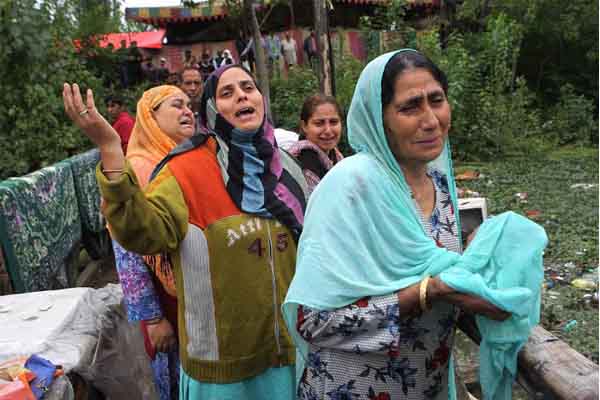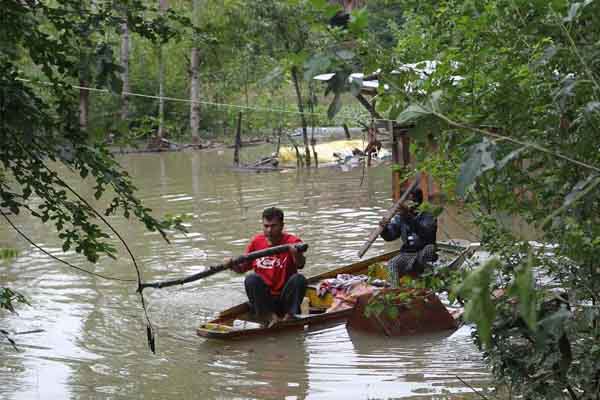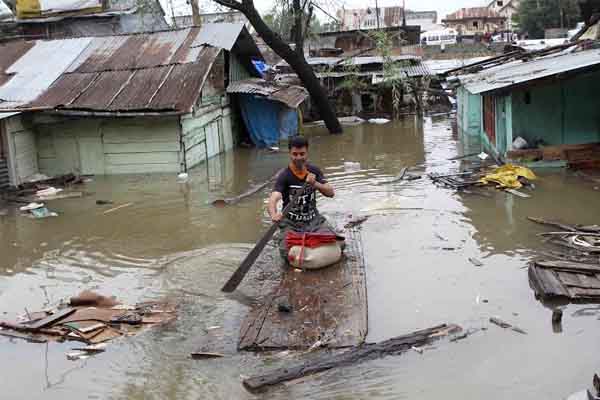
The distressing impact of the recent floods in Jammu and Kashmir is undeniably manifold. If one were to put it plainly, the first and last casualty remains the common Kashmiri — the one who lost his/her life, the one who is mourning that loss, the one who has been rendered homeless, the one whose business has suffered or collapsed, the one who partakes in rescue and relief operations or the one who has to rebuild and reconstruct everything, brick by brick, in a now ‘refugee’ valley.
My personal memories of the worst flood in Kashmir’s recent history are varied.
I met 65-year old Gulshan and her seven-year-old grandson at a hair saloon in Srinagar on the eleventh day of the floods. The duo looked sullen and I realised that they may have not had water to even bathe, for about two weeks. They appeared sick and were in a miserable condition.
Where do you come from, I asked Gulshan. Her ordeal was heart wrenching. A resident of Gangbugh, Tengpura in Srinagar, Gulshan was at home when the gushing sound created by the flood waters disturbed her sleep in the intervening night of September 6-7. As soon as she opened her eyes, she recalls, she woke up to a disturbing reality — the first floor of her house was completely inundated.
“I didn’t know what to do. All I remember is that I cried out aloud and woke my husband, son and daughters up,” she said.
Her husband suffered from multiple heart ailments and is unable to generate income for the family while one of her sons was enforced to custodial disappearance by the Indian army in March 1997, she said. So her second son took care of the family’s financial needs.
On the morning of September 7, some local volunteers and boatmen rescued the family, but Gulshan’s son stayed back in the second storey of the house to take care of the family's valuables. “Umar didn’t agree to come with us. He insisted he would stay inside. We failed to convince him,” she told me. Gulshan’s family was rescued and relocated to a relief camp set up in a marriage hall in Sanat Nagar, Srinagar, which is named after famous Urdu poet Dr Allama Iqbal. According to the volunteers, over 2,000 people had taken shelter in the relief camp there by then.
A stone’s throw away from this relief point, a group of young Kashmiri doctors led by Dr Zahida and Dr Sajad Fazili have set up a free medical camp, where flood victims are being treated. Dr Yasir Wani, a young paediatrician, is also part of this group of doctors and would initially treat sick children from morning until late evening before he had to join his official duties in the neighbouring district of Budgam on September 15. He continues to offer his voluntary services at the camp in the evenings.
About 7,000 flood survivors had taken shelter in the three relief camps within one kilometre range from Sanat Nagar to Baghat Barzulla. They included children, women and elderly people. Most of them have now gone to their homes to assess the damage and hopefully with a resolve to start their lives afresh.
The severely affected flood areas in Srinagar city included Jawahar Nagar, Gogji Bagh, Rajbagh, Kursoo, Sonwar, Mehjoor Nagar, Allochi Bagh, Exchange Road, Press Enclave, Batamaloo, Bemina, Chattabal, Qamarwari, Karan Nagar, etc. Government’s top edifice civil secretariat, J&K High Court, Press Enclave, renowned Broadway hotel, Coffee Arabica, Sher-i-Kashmir Cricket Stadium, and the Indian army’s Srinagar-based 15 Corps (Badami Bagh Cantonment) were all marooned in 12 feet of water or more.
The local administration was invisible on the ground for nearly two weeks. There was scarcity of drinking water, no traffic cops on the roads, no municipality workers or sweepers to dispose garbage and all channels of communication had broken down.
Some members of India’s National Disaster Response Force (NDRF), Jammu & Kashmir Light Infantry (JAKLI), and other government forces were seen aiding in rescue and relief operations at some places. Also, four army helicopters were seen air-dropping food packets to people trapped in waterlogged areas. However, the major rescue and relief work was solely being performed by Kashmiri volunteers, young men and local boatmen.
I remain an eyewitness to the scenes where people suffering on account of the flood — both elite and poor—spread their hands out to collect some ‘tehri’ (rice cooked with turmeric/haldi) from a relief camp set up on a Srinagar bridge.
I remain an eyewitness to inexplicable scenes wherein Kashmiri bravehearts rescued many pregnant women from inundated areas and carried the distressed on their shoulders while wading through flood waters in trying circumstances.
I remain an eyewitness to the scenes where some Kashmiri boatmen rescued hundreds of people in their boats, without getting any credit for their heroic efforts on prime time television debates, in which anchors portray themselves as experts of an area they have never bothered to visit.
I remain an eyewitness to the sight of one medical doctor, who remained trapped in submerged waters for four consecutive days along with his family, but resumed work in no time to offer his professional services, medical advice and medicines for free.

Photo credit: Javed Dar
I remain an eyewitness to the sights where a Kashmiri Muslim boatman offered his services to rescue a Sikh family, and to the organisers at a Gurudwara in Srinagar that gave shelter to some Muslim families.
I remain an eyewitness to the scenes of relief trucks from Shopian, Yusmarg and Uri reaching Srinagar to distribute rice, fruits, vegetables and other materials for free as part of a humanitarian gesture.
Sadly, I also remain an eyewitness to the sight of one elderly patient who wanted to see a doctor in waterlogged hospitals of Srinagar but couldn’t find one. Or the scenes near a filling station in Srinagar where some people procured petrol in a huge quantity only to sell that to fellow Kashmiris in need at exorbitant rates (between Rs 100 to 150 per litre). One of my teachers brought petrol Rs 100 a litre in Srinagar! I was also witness to a scene where a burglar from another district was caught red handed near the river embankment in Srinagar, trying to take undue advantage of the flood crisis.

Photo credit: Javed Dar
I also witnessed the strange absence of cops in police stations, traffic policemen on roads, municipality workers in their respective wards, district officers in their areas and civil administrators and other government servants for more than a week, beginning September 7.
Fortunately, however, there are more stories of valour, heroism and volunteerism than tales of disappointment.
A police officer, who rescued many people in one particular area in Srinagar, told me that when people raised slogans in his favour, he thought he had received the biggest award and highest honour in his professional career thus far. “I don’t know how to swim. I don’t know how to row a boat. But I told myself if I can’t do anything now, I can never ever deliver anything. I rescued children who were trapped in an Islamic seminary in Srinagar as well as women and elderly people. My efforts gave me a lot of personal satisfaction,” the police officer says.
Another young man bought a special rafting boat from outside Kashmir by paying a lot of money, to get involved in rescue operations in Srinagar and South Kashmir. “Whatever I did and am doing, it is for my people. I don’t expect any rewards in this world. I do everything for my life hereafter (aakhirat),” the young boy says.

Photo credit: Javed Dar
A group of young Kashmiri boys have decided to adopt some families for at least six months by taking care of all expenditures—cooking gas, rice, clothing, medicine, school fee, etc.
Kashmir’s young generation proved to themselves and to the entire world that Kashmir is in safe hands. They showed that the older generation can rely on them for Kashmir’s bright and secure future. Young Kashmir showed that it has the capacity to self-govern and turn crisis into opportunity. Young Kashmir showed it can manage disasters and organise when corrupt and inefficient governments fail to deliver.
Meanwhile, nearly three weeks after the flood fury, resilient Kashmir is limping back to some semblance of normalcy. The flood fury has rendered hundreds of families homeless, businesses have collapsed and there are enormous health concerns too. But Kashmir remains resilient as ever.
The author is a journalist.